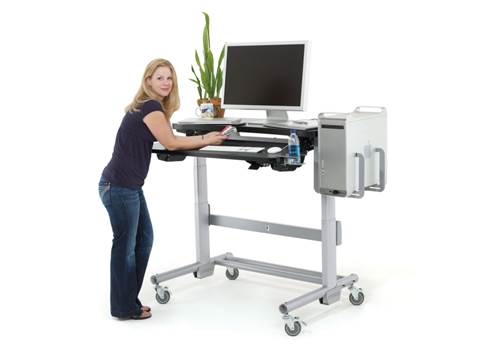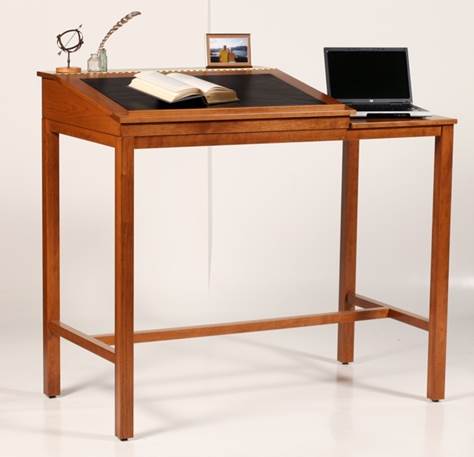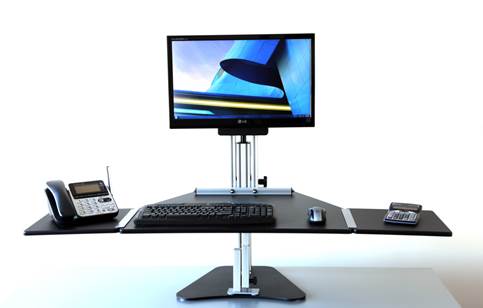Can standing desk improve health, or
are they just a fad? We explains the pros and cons of using a standing desk
Most of us don’t sit quite the way we
should. We slouch or slump in our chairs and may not even have the chair itself
configured correctly. We know we’re supposed to keep our backs straight and our
knees bent at 90 degrees, but few of us actually bother to do this.

Can
standing desk improve health, or are they just a fad?
Now, a growing number of people are
discarding their chairs entirely and switching to taller desks designed for use
while standing – or desks that can be easily switched to suit either position.
Users of standing desks claim to have more energy in the office and improve
overall health.
It’s a tempting idea but if you’re thinking
of using a standing desk, there are some things you need to know first.
Are you sitting comfortably?
The idea of using a desk while standing up
may seem unnatural, but a sedentary lifestyle has been shown by several studies
to have long-term health ramifications. A peer-reviewed study by Dr Emma Wilmot
of the Diabetes Group at the University of Leicester has found that sitting at
a desk all day damages your long-term health regardless of overall fitness. In
other words, even if you exercise, eat your five a day and have a balanced
lifestyle, sitting for prolonged periods raises the risk of developing
diabetes, heart disease and several cancers.
There are postural concerns, too. Sitting
down isn’t inherently bad for your back, but you should take regular breaks
from your chair. Ensure both your chair and desk are configured for good
posture – most people don’t do this, and the result is an increased occurrence
of all manner of medical conditions, from RSI to back and neck problems.
Obesity is a problem, too, when you spend
all day sitting. Standing desks can help here in a number of ways. Most
obviously, standing requires more energy than sitting. On a minute-to-minute
basis the difference is small, but multiplied over a full working day the
calories your burn off will add up. Simply standing up more can prevent you
from gaining weight, if not help you lose it.

Obesity
is a problem, and standing desks can help here in a number of ways
The secondary benefits are psychological.
Individuals who have switched to standing desks have found themselves
approaching their work in a new way.
“It’s definitely changed the way I work,”
says Dean Gifford, a software developer who has been using a standing desk for
the past year. “When you don’t have to sit down, it feels like less of a heavy
decision to walk up to your desk and start on something.”
Staying on your feet also makes it much
easier to walk away from the desk, encouraging a more active routine. Those
breaks and stretches you never do when you’re sitting down? At a standing desk
they become part of the natural rhythm.
Using a standing desk isn’t a magic bullet
for workplace health problems, however. “There’s a lot more to computer-related
injuries,” warns Dr. John Outhwaite, a consultant at the London Orthopaedic
Clinic who specializes in workplace injuries. “Things such as the ambient
temperature and the way the light falls on the screen can be important,” he
claims, as well as the design of hardware and software. If you want to improve
your working environment and practices, switching to a standing desk is a
start, not an end.
Standing tall
If you’re willing to invest in a standing
workstation, you’ll find a good range of options available. Ergo Desktop’s
Kangaroo desk stands, for example, sit on top of standard-sized office desk and
raise your monitor and keyboard to standing height, with prices starting at
around $450 excluding VAT. Posturite’s sit-stand desks are height-adjustable,
letting you move between positions as you see fit; the simplest option costs
around $750, while a corner desk will set you back over $2,700.
This height-switching ability is good for
hot-desking environments where not everyone may want to stand. It also makes it
easy to take a break from standing if you feel fatigued. We asked a selection
of five standing-desk users how easy they’d found it to switch, and all agreed
it had taken time to adjust. A few people kept stools around so that they could
change position easily. This needn’t undermine the benefits of standing; moving
between positions from time to time could actually be better for you than
sticking solely to either a good standing or sitting position.

Ergo
Desktop’s Kangaroo desk stands, for example, sit on top of standard-sized
office desk and raise your monitor and keyboard to standing height
“The ideal situation is being able to move
from sitting to standing as needed,” says Dr. Outhwaite. “This will give you
control of your posture, and lets you use a standing desk as part of a general
preventative package for orthopaedic issues.
“The ability to change the height of the
desk stops the muscles getting set in one position. What you’d want is a desk
with controls that are easy to get at, with a powerful motor.”
If a sit-stand desk isn’t an option then it
might be a good idea simply to keep a stool handy, take regular breaks from
work – or consider a desk with a built-in treadmill that keeps you moving. Yes,
these do exist, and yes, they seem rather ludicrous to us as well.
When choosing a desk, be warned that terms
such as “orthopaedic” and “ergonomic” have no objective meaning as far as the
products are concerned. Unless specifically designed for your body or medically
prescribed, an orthopaedic or ergonomic desk can be worse for you than a cheaper
alternative.
“The individual should be looked at by
someone competent and in situ,” recommends Dr Outhwaite. “The body will
naturally adopt the least energy-expensive posture for what you’re doing and it
will then learn that, so every time you sit down in a chair you’ll take that
position.”
That position frequently involves being
hunched forwards, with the neck angled slightly downwards. That isn’t a healthy
position and, once your body has “learned” that posture, it can be difficult to
change it. That’s why it’s important to use furniture that’s right for your
size and is properly adjusted; don’t just opt for a reassuringly expensive
option.
“The trouble here is to do with
anthropometrics,” adds Tim Hutchful of the British Chiropractic Association.
“What’s comfortable for one person isn’t always comfortable for another. I have
a friend, for example, who is the same height as me, but what’s good for him
isn’t good for me because I have longer legs.”
A large number of standing-desk users find
themselves either experimenting with DIY solutions customized to their
proportions or favoring bracket-based solution such as the Kangaroo range of
stands. These allow the position and height of individual components to be
tailored to suit the specific individual.